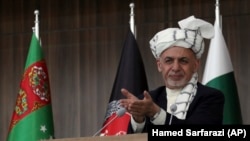Afghan President Ashraf Ghani has apologized to the families of victims of an airstrike by the country’s forces that killed dozens -- mostly children -- in a restive province bordering Central Asia last month.
On May 16, Ghani met with the families of the victims, most of whom were students of a religious school in Dasht-e Archi, a rural district of the northern Kunduz Province.
The United Nations Assistance Mission in Afghanistan (UNAMA) said 36 people, including 30 children, were killed in the April 2 attack by the Afghan Air Force. The organization’s investigation made public on May 7 established that 71 more people, mostly children, were also injured.
“The Afghan government in general and the Afghan Defense Ministry in particular apologizes to the families of the victims of this attack,” Ghani said. “The key difference between the government and insurgents is that a legitimate government will always seek forgiveness for mistakes.”
The apology followed weeks of official denials. In its initial reaction, Kabul said the airstrikes had targeted senior Taliban leaders, including members of the Taliban leadership council, the Quetta Shura. Afghan officials said fighters from the Taliban special forces or commando unit, formally called the Red Unit, were also killed in the attack.
Even last week, the Afghan Defense Ministry insisted that based on its intelligence reports, 18 important Taliban commanders, including Mawlawi Baryal, a member of the Quetta Shura, were killed in the attack.
“Twelve more Taliban commanders were injured in this strike,” a statement by the ministry claimed on May 8. “Unfortunately, the Taliban used people as a shield. Nine civilians were killed and 55 more were injured in the attack.”
UNAMA called on Kabul to conduct a prompt, impartial, and transparent investigation to “ensure accountability for perpetrators and make public the findings and measures taken.”
Ghani, however, was vague about what exact steps his government would take to address this issue. “I have told the defense minister to be very diligent in carrying out airstrikes so we can prevent such incidents,” he said.
Civilian casualties in airstrikes have been a major hallmark of the current Afghan war since 2001. The Taliban often portray such casualties as evidence of their claims that foreign and Afghan forces target Afghan civilians.
In a report earlier this year, UNAMA documented 10,453 civilian casualties across Afghanistan last year. These included 3,438 dead and 7,015 wounded.
While the report said that most attacks were caused by insurgent violence, it noted 631 civilian casualties in aerial attacks. These included 295 deaths and 336 injuries.
As part of U.S. President Donald Trump’s Afghanistan strategy, NATO and Afghan forces are seeking to increase military pressure on the insurgents. They often rely on airstrikes to target insurgents in the vast countryside. The Afghan Air Force, equipped with Brazilian A-29 Super Tucano combat aircrafts and attack helicopters, is now playing a greater role in the air war.






